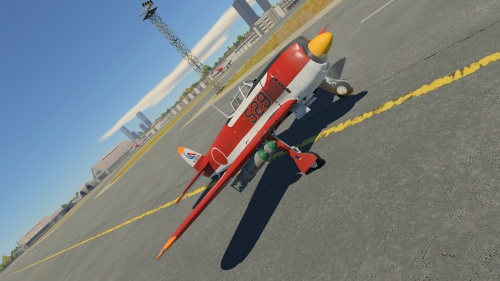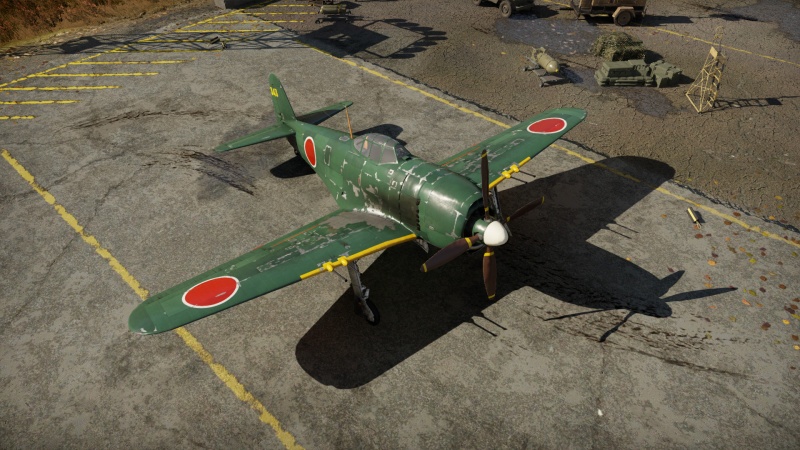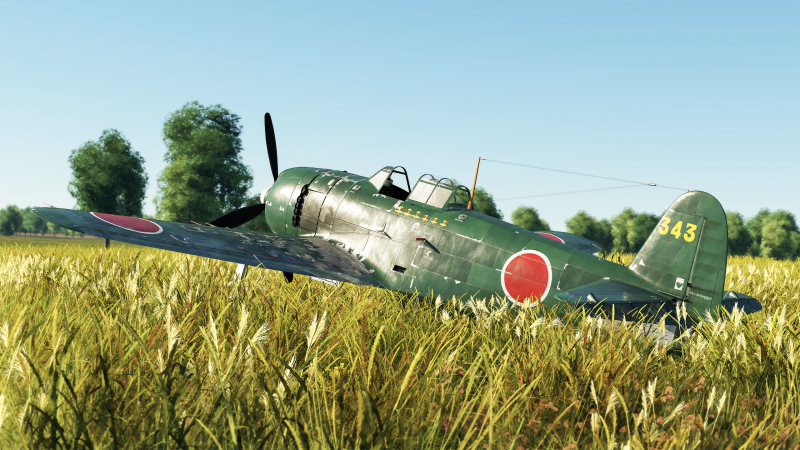Difference between revisions of "N1K2-Ja"
U120610831 (talk | contribs) (→Survivability and armour: EFS added in latest update) (Tag: Visual edit) |
(Edits) |
||
| Line 78: | Line 78: | ||
* 70 mm Bulletproof glass - Armoured windscreen | * 70 mm Bulletproof glass - Armoured windscreen | ||
* 12 mm Steel plate in pilot's seat | * 12 mm Steel plate in pilot's seat | ||
| − | + | * Engine fire system (EFS) | |
| − | Engine fire system (EFS) | ||
=== Modifications and economy === | === Modifications and economy === | ||
Revision as of 10:08, 21 December 2022
| This page is about the Japanese fighter N1K2-Ja. For other variants, see N1K (Family). |
Contents
Description
The N1K2-Ja Shiden-Kai is a rank Japanese fighter with a battle rating of (AB), (RB), and (SB). It has been in the game since the start of the Open Beta Test prior to Update 1.27.
General info
Flight performance
| Characteristics | Max Speed (km/h at 6,000 m) |
Max altitude (metres) |
Turn time (seconds) |
Rate of climb (metres/second) |
Take-off run (metres) | |||
|---|---|---|---|---|---|---|---|---|
| AB | RB | AB | RB | AB | RB | |||
| Stock | 626 | 610 | 19.8 | 20.4 | 14.2 | 14.2 | 300 | |
| Upgraded | 675 | 650 | 18.5 | 19.0 | 23.2 | 18.2 | ||
Details
| Features | ||||
|---|---|---|---|---|
| Combat flaps | Take-off flaps | Landing flaps | Air brakes | Arrestor gear |
| ✓ | ✓ | ✓ | X | X |
| Limits | ||||||
|---|---|---|---|---|---|---|
| Wings (km/h) | Gear (km/h) | Flaps (km/h) | Max Static G | |||
| Combat | Take-off | Landing | + | - | ||
| 498 | 469 | 320 | ~12 | ~10 | ||
| Optimal velocities (km/h) | |||
|---|---|---|---|
| Ailerons | Rudder | Elevators | Radiator |
| < 430 | < 460 | < 400 | > 324 |
Survivability and armour
- 70 mm Bulletproof glass - Armoured windscreen
- 12 mm Steel plate in pilot's seat
- Engine fire system (EFS)
Modifications and economy
Armaments
Offensive armament
The N1K2-Ja is armed with:
- 4 x 20 mm Type 99 Model 2 cannons, wing-mounted (250 rpg outer + 200 rpg inner = 900 total)
Suspended armament
The N1K2-Ja can be outfitted with the following ordnance:
- Without load
- 4 x 60 kg Navy Type 97 Number 6 bombs (240 kg total)
- 2 x 250 kg Navy Type 98 Number 25 bombs (500 kg total)
- 2 x Type 3 No.1 Mod.28 Mk.1 rockets
- 2 x Type 5 No.1 Mod.9 rockets
- 2 x Type 3 No.6 Mod.27 Mk.1 rockets
- 2 x Type 5 No.6 Mod.9 rockets
Usage in battles
The N1K2-Ja is a very tricky aircraft to use. It can face early jet fighters such as the F-80A-5, Yak-15/17, He 162, J/A21R, and in Arcade, the F-84B-26. These jet aircraft hold a hefty speed advantage over the Shiden-Kai, but typically have very poor manoeuvrability, meaning the N1K pilot can abuse its excellent handling at medium speeds and shred the previously mentioned jets if their pilots are foolish enough to try and turn-fight. The one exception to this is the Yak-15, which retains the turning abilities of its airframe; the Yak-3. However, the Yak-15 suffers from a relatively low top speed and climb rate for a jet, along with sub-par vertical energy retention. Above all those, its ammunition pool is abysmal at only 120 rounds total, meaning the N1K2 pilot could potentially win an engagement just by remaining difficult to hit.
Although it can fight admirably against jets, the N1K2-Ja will find itself coming up short against many of the other nation's top tier superprops. It cannot keep up with the P-51H, F4U-4B, F8F, I-225, La-9, Tempests, Griffon Spitfires, G.56, late Bf 109s, or Fw 190 D's of its tier. Fortunately, most of the previously mentioned aircraft cannot turn with the N1K2, so the Shiden-Kai can use its superb mid-speed manoeuvrability to turn circles around its opponents. The main exception to this is the uncommon G.56, which is the closest thing the N1K2 has to a hard counter. It can turn with it, outspeed it, out-dive it, beat it in an energy fight and shred it with the triad of 20 mm MG 151s, so it is highly recommended to either avoid the G.56 or take it out while it's preoccupied with a teammate.
The N1K2-Ja can take on a relatively new role for Japanese fighters; a fighter/bomber. With its ability to mount 2 x 250 kg bombs or two of the massive Type 5 No.6 rockets, the N1K2 can be Japan's best ground attacker and will make enemy tanks quake in fear. The Type 98 Number 25 bombs are roughly equivalent to the American AN-M64A1 500 lb bombs, and are mounted on wing racks, allowing for precise bomb placement on targets. On the flip-side, the Type 5 No.6 rockets have no direct comparison but play somewhat similarly to a watered-down American Tiny Tim rocket or Swedish hprak m/49 rocket. Despite their relatively low velocity and higher weight, they are still quite accurate and are able to be launched quite close to the target with minimal threat of self-damage.
Manual Engine Control
| MEC elements | ||||||
|---|---|---|---|---|---|---|
| Mixer | Pitch | Radiator | Supercharger | Turbocharger | ||
| Oil | Water | Type | ||||
| Controllable | Controllable Not auto controlled |
Controllable Not auto controlled |
Controllable Not auto controlled |
Separate | Controllable 2 gears |
Not controllable |
Pros and cons
Pros:
- Flight performance
- Reasonable manoeuvrability at medium speeds (300-500 km/h)
- Great energy retention
- Solid acceleration once upgraded
- Combat flaps are efficient while in dogfighting
- Decent rate of climb
- Relatively good diving characteristics for a Japanese aircraft
- Armament
- Absurd amount of ammunition (200-250 rpg with 900 rounds in total)
- Cannons themselves are reasonable in all aspects, and take far longer to jam than their contemporaries
Cons:
- Flight performance
- Mediocre roll rate
- Severely stiffens at higher speeds
- Can be outmanoeuvred easily by the fighters at its tier if not used correctly
- Unless approached correctly, completely outclassed by the Spitfire Mk. IX and F8Fs
- Stock grind can be outright painful
- Weak stock belts, which require a tier III modification to upgrade
- Can catch on fire easily, and often gets destroyed in the process
- Often faces jets
- Slow in comparison of what it has to face
History
| Archive of the in-game description | |
|---|---|
|
Kawanishi Shiden-Kai Model 21Ko, Kawanishi N1K2-Ja (code name "George") Marine Interceptor-Fighter This fighter-bomber version of the N1K2, the N1K2-Ja Model 21Ko, was developed at the time the N1K2-J began production. The main difference between the two planes was the 21Ko's steel underwing pylons. This Shiden-Kai could carry four 250-kg bombs, two under each wing, or two 500-kg bombs, or two or four 60-kg bombs. It could also carry unguided rockets, like the N1K2-J. The N1K2-Ja could be visibly distinguished from its predecessor by the lower position and reduced area of its horizontal fin. Upon its success in factory testing, the N1K2-J was selected by the Japanese Imperial Navy as its primary fighter and fighter-bomber. The Navy's plan was to launch large-scale mass production of the Shiden-Kai, but its production was always behind schedule. The situation became more critical when American B-29 Superfortress bombers began attacking Japanese industrial sites. The attacks did not target the production facilities containing the Shiden-Kai assembly lines, but supply companies were attacked, leading to a shortage of sheet metal, forged steel, stamped aluminum, and engine and chassis parts. N1K1-J fighters were first used in battle near Lake Sebu in October 1944, then used en masse in the Philippines. From the end of 1944 on, the N1K1-J and N1K2-J aircraft were primarily used for the defense of the Japanese homeland. The most famous squadron of Shiden-Kai was formed in December 1944. Known as the 343rd Kokutai, it was under the command of the most experienced Japanese naval commander, Minoru Genda. His squadron consisted of Japanese aces, and their planes were all N1K2-Js. This "Genda's Blade" squadron was known as a squadron of experts, the elite of the Imperial Navy's aviators. The Americans quickly felt their skill in battle. For instance, in February of 1945, Midshipman Kaneyoshi "Kinsuke" Muto, piloting an N1K2-Ja, single-handedly attacked 10 F6F Hellcats, shooting four of them down and forcing the others to retreat. The Shiden-Kai was an extremely unpleasant surprise for the Americans. The original Shiden was good, but this model, free of its predecessor's "childhood illnesses", was superb. It would soon become clear that even a pilot of average skill in a Shiden-Kai could challenge any Allied fighter, even the P-51 Mustang, which began its fight in the skies over Japan in the spring of 1945. Production of the N1K2-J ended after Japan surrendered. In all, 1,435 Shidens of all variants were constructed, including 998 N1K1-Js and 415 N1K2-Js. | |
Media
- Skins

See also
- Related Development
- N1K1 - (Kyofu Model 11; Base hydroplane model)
- N1K1-Ja - (Shiden Model 11A; N1K1-J with 7.7mm's removed from the fuselage and 4x20mm in the wings)
- N1K2-J - (Shiden Kai Model 21; Redesigned wings and fuselage)
External links
| Kawanishi Aircraft Company (川西航空機) | |
|---|---|
| Fighters | J6K1 |
| N1K | N1K1-Ja · N1K2-J · N1K2-Ja |
| Bombers | H6K4 · H8K2 · H8K3 |
| Hydroplane | N1K1 · E7K2 |
| Japan fighters | |
|---|---|
| Navy | |
| Carrier-based fighter | |
| A5M | A5M4 · Hagiri's A5M4 |
| A6M | A6M2 mod. 11 · A6M2 · A6M3 · A6M3 mod. 22 · A6M3 mod. 22Ko · A6M5 · A6M5 Ko · A6M5 otsu · A6M5 Hei · A6M6c |
| A7He | A7He1* |
| A7M | A7M1 (NK9H) · A7M2 |
| Land-based Fighter | |
| J2M | J2M2 · J2M3 · J2M4 Kai · J2M5 · J2M5 (30 mm) |
| J6K | J6K1 |
| J7W | J7W1 |
| N1K-J | N1K1-Ja · N1K2-J · N1K2-Ja |
| Fighter seaplane | |
| N1K | N1K1 |
| A6M-N | A6M2-N |
| Army | |
| Ki-10 | Ki-10-I · Ki-10-I C · Ki-10-II · Ki-10-II C |
| Ki-27 | Ki-27 otsu · Ki-27 otsu Tachiarai |
| Ki-43 | Ki-43-I · Ki-43-II · Ki-43-III otsu |
| Ki-44 | Ki-44-I · Ki-44-I 34 · Ki-44-II otsu · Ki-44-II hei |
| Ki-61 | Ki-61-I ko · Ki-61-I otsu · Ki-61-I hei · Tada's Ki-61-I hei · Ki-61-I tei · Ki-61-II Otsu Kai |
| Ki-84 | Ki-84 ko · Ki-84 otsu · Ki-84 hei |
| Ki-87 | Ki-87 |
| Ki-94 | Ki-94-II |
| Ki-100 | Ki-100 · Ki-100-II |
| Other countries | ▅F4U-1A · ▅P-51C-11-NT · ▅Bf 109 E-7 · ▅Fw 190 A-5 |
| *Imported designation of the He 112 (A6M was in development - A7M would take A7 designation after the cancelation of the A7He) | |






